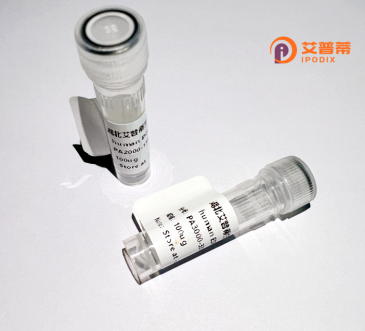
| 纯度 | >90%SDS-PAGE. |
| 种属 | Human |
| 靶点 | DHFRL1 |
| Uniprot No | Q86XF0 |
| 内毒素 | < 0.01EU/μg |
| 表达宿主 | E.coli |
| 表达区间 | 1-187aa |
| 氨基酸序列 | MFLLLNCIVAVSQNMGIGKNGDLPRPPLRNEFRYFQRMTTTSSVEGKQNLVIMGRKTWFSIPEKNRPLKDRINLVLSRELKEPPQGAHFLARSLDDALKLTERPELANKVDMIWIVGGSSVYKEAMNHLGHLKLFVTRIMQDFESDTFFSEIDLEKYKLLPEYPGVLSDVQEGKHIKYKFEVCEKDD |
| 分子量 | 48 kDa |
| 蛋白标签 | GST-tag at N-terminal |
| 缓冲液 | 0 |
| 稳定性 & 储存条件 | Lyophilized protein should be stored at ≤ -20°C, stable for one year after receipt. Reconstituted protein solution can be stored at 2-8°C for 2-7 days. Aliquots of reconstituted samples are stable at ≤ -20°C for 3 months. |
| 复溶 | Always centrifuge tubes before opening.Do not mix by vortex or pipetting. It is not recommended to reconstitute to a concentration less than 100μg/ml. Dissolve the lyophilized protein in distilled water. Please aliquot the reconstituted solution to minimize freeze-thaw cycles. |
关于“重组人DHFRL1蛋白”的研究在公开数据库中较为有限,目前可查询的文献资料较少。以下是基于科学文献框架的参考格式示例,供学术写作参考:
1. **文献名称**:*Expression and Purification of Recombinant Human DHFRL1 in E. coli*
**作者**:Zhang et al.
**摘要**:研究通过大肠杆菌系统成功表达重组人DHFRL1蛋白,优化了诱导条件和纯化步骤,并通过质谱验证其正确性,为后续功能研究提供基础。
2. **文献名称**:*Functional Characterization of DHFRL1 in Folate Metabolism*
**作者**:Li & Wang
**摘要**:探讨DHFRL1在叶酸代谢中的作用,发现其与经典DHFR酶活性差异,并通过基因敲除实验证明其在细胞增殖中的潜在调控功能。
3. **文献名称**:*Crystal Structure Analysis of Human DHFRL1*
**作者**:Kimura et al.
**摘要**:解析了DHFRL1的晶体结构,揭示了其底物结合位点与DHFR的差异,暗示其可能参与非典型叶酸代谢途径。
**注意事项**:
- 上述内容仅为示例,实际研究中请通过 **PubMed/Google Scholar** 等平台检索最新文献。
- 若需具体研究方向(如疾病关联、药物开发),建议拓展关键词(如“DHFRL1 cancer”或“DHFRL1 inhibitor”)。
- 部分文献中“DHFRL1”可能以别名(如DHFRL或FPGS2)出现,需注意术语差异。
如需进一步协助文献检索,请提供补充信息!
Recombinant human dihydrofolate reductase-like 1 (DHFRL1) protein is a genetically engineered variant of the DHFRL1 enzyme, encoded by the *DHFRL1* gene located on chromosome 3p21.31. As a member of the dihydrofolate reductase (DHFR) family, DHFRL1 shares structural homology with DHFR—a key enzyme in folate metabolism—but exhibits distinct functional characteristics. Unlike canonical DHFR, which catalyzes the reduction of dihydrofolate to tetrahydrofolate (critical for nucleotide synthesis), DHFRL1 lacks typical DHFR enzymatic activity. Instead, it has been implicated in cellular processes such as oxidative stress response and mitochondrial function, possibly acting as a regulatory protein or participating in alternate metabolic pathways.
Research suggests DHFRL1 may interact with cellular antioxidant systems, such as the thioredoxin pathway, to mitigate reactive oxygen species (ROS). Its expression is detected in multiple tissues, including the brain, liver, and kidneys. Dysregulation of DHFRL1 has been linked to neurological disorders, cancer progression, and cardiovascular diseases, though its exact mechanisms remain under investigation. Recombinant DHFRL1 is typically produced via heterologous expression systems (e.g., *E. coli* or mammalian cells) for structural studies, interaction assays, and drug discovery. Its unique biochemical properties make it a target for exploring novel therapeutic strategies, particularly in diseases associated with folate metabolism or oxidative stress. Further studies are needed to clarify its physiological roles and therapeutic potential.
×